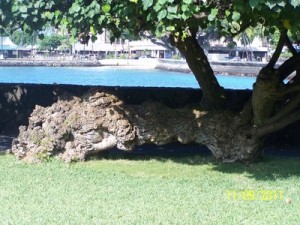Big Island Now Known For Big Trees
Several tree species are looming large on the Big Island.
That’s the word from American Forests, a non-profit conservation organization that keeps track of such things.
The group today released its list of the biggest individual trees in the nation, and six of them are located in Hawaii, with three of them in Hawaii County.
The American Forests’ 2012 National Register of Big Trees lists the 761 champions and co-champions across the country. Another 220 species are awaiting a champion.
The register is based on a combination of three attributes: circumference in inches, and height and average crown spread, both of which are measured in feet. The three numbers are totaled to give each tree its total points.
The Big Island champs are a manele tree in Hawaii Volcanoes National Park, a hau tree on the grounds of the Hulihe‘e Palace in Kailua-Kona and a koa tree in South Kona.
The first two are accessible by the public; the 115-foot-tall koa tree located in the remote Kona Hema Preserve managed by The Nature Conservancy on the western slope of Mauna Loa is not.
The three other Hawaii trees on the register are two coconut palms in the Royal Coconut Grove in Kapuaiwa, Molokai which, with heights of 103 and 99 feet, share the title of co-champions for the species Cocos nucifera, and an ‘a‘ali‘i or hopbush tree at the Maui Nui Botanical Garden in Kahului. The ‘a‘ali‘i tree is also a co-champion, sharing the honor with a tree in Arizona.
The Hawaii candidates were submitted to American Forests by the state Department of Land and Natural Resources, based on recommendations from the public.
“With forests covering approximately 749 million acres in the US, it’s a special honor to have a tree recognized as the biggest of its kind,” said Paul Conry, administrator of the DLNR’s Division of Forestry and Wildlife.
It’s understandable that the biggest koa was found in Hawaii, because it is endemic to the state (16 new native and naturalized Hawaiian species were just recently added to the list). But Hawaii’s other champion individuals are also found elsewhere.
For instance, the hau tree in Kona, which stands 20 feet in height, is not particularly tall by typical hau standards. According to the US Forest Service, the tree known commonly as sea hibiscus can reach heights of up to 33 feet.
But it’s this tree’s girth that makes it special.
American Forests mandates that the circumference of candidate trees be measured 4½ feet from its base.

This Kona hau tree's diameter of nearly three feet helped earn it the distinction of the biggest individual of its species in the US. DLNR photo.
The Kona hau tree’s trunk measures 110 inches around, giving it a diameter of more than 35 inches – seven times that of a normal hau, according to Forest Service data.
The koa tree is no shrinking violet itself, with a circumference of 343 inches. That works out to a diameter of more than nine feet.
The third Big Island beast, the manele tree in Kipuka Puaulu, also known as Bird Park, is 73 feet tall. The tree, which is known outside Hawaii as soapberry wingleaf, typically maxes out at 50 feet.
Of course, if you’re looking for really big trees, you’re talking about the massive evergreens on the west coast of the mainland.
The register’s biggest is a giant sequoia in Sequoia National Park in California. At 274 feet in height it’s not the tallest, but its 1,020-inch circumference (27-foot diameter) carries the day.
Next up are the register’s tallest trees, four co-champion coast redwoods in California that range from 299 to 349 feet in height. The biggest has a diameter of 25 feet.
Rounding out the top 10, in terms of total points, are three trees in Washington’s Olympic National Park: a 159-foot western red cedar, a 191-foot Sitka spruce and a 281-foot coast Douglas fir; a 242-foot Port-Orford cedar in Coos, Ore.; and an 82-foot common bald cypress in Cat Island, LA with a whopping 99-foot crown spread.
And who knows – take a look around, because there could be a winner in your back yard.
The register’s record for an avocado tree is only 72 feet tall, but the specimen in Orange, Calif. does have a diameter of nearly five feet and a 59-foot spread.
Candidate trees’ measurements, along with its GPS coordinates or specific directions, can be submitted to DOFAW’s Sheri Mann at [email protected].
















